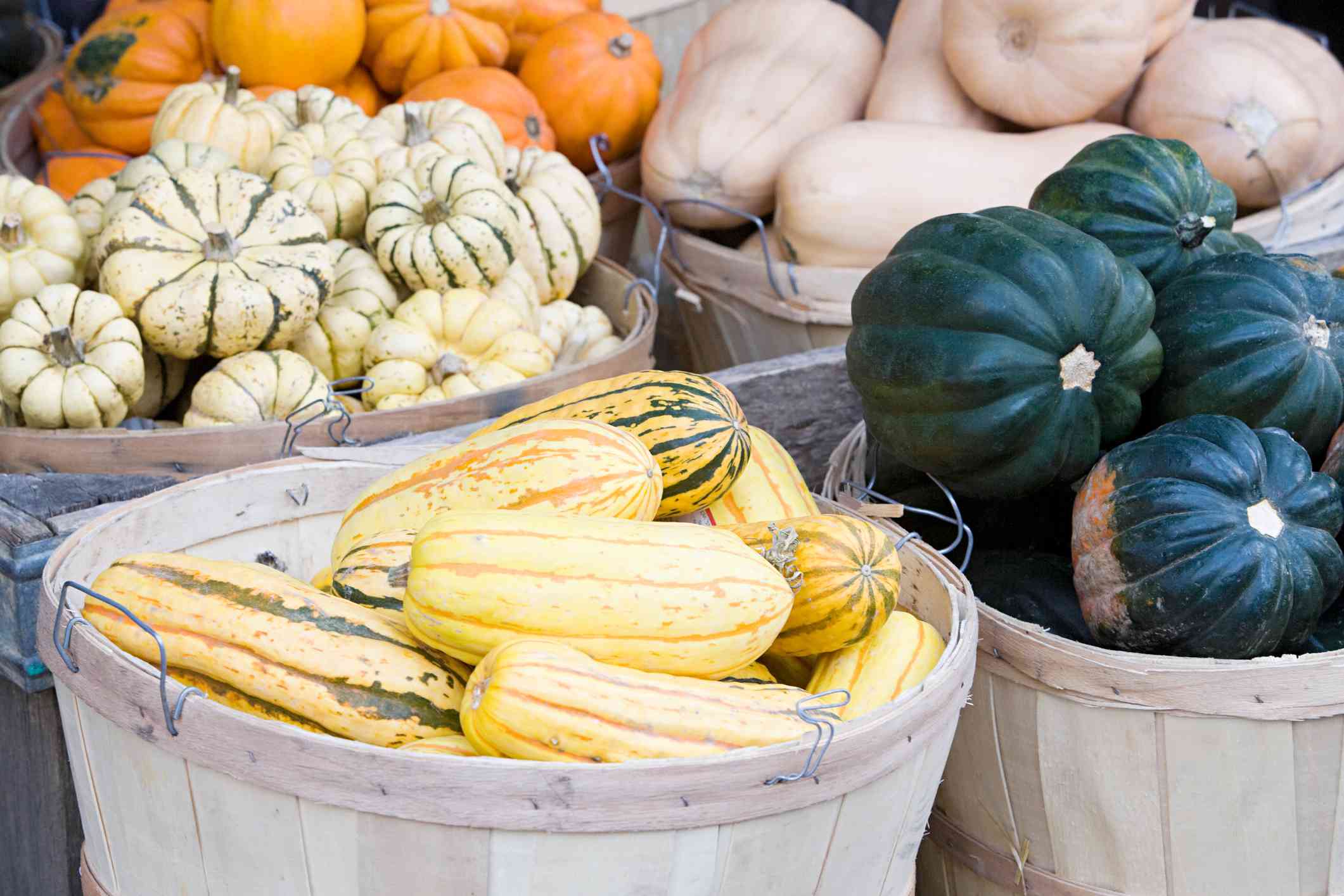Squash and pumpkins come in a stunning array of shapes sizes, colors and flavors. While we often think of round orange pumpkins when fall arrives there are actually dozens of different varieties to discover. From tiny delicate gourds to mammoth hundred-pound beasts, squash offer something for everyone.
Squash are extremely diverse but they can generally be divided into two main categories – summer squash and winter squash. Summer squash tend to have thin edible skins and moist flesh. They are best eaten fresh and include favorites like zucchini and yellow squash. Winter squash have tough inedible rinds and firm, sweet flesh. They store well and include types like acorn squash, butternut squash and pumpkins.
Here is an overview of some of the most common varieties of winter squash and pumpkins you’re likely to encounter:
Acorn Squash
Acorn squash are one of the most widely available winter squash. Named for their acorn shape, these squash have dark green skin splotched with orange. The flesh is slightly sweet and perfect for roasting, stuffing, or adding to soups and stews. Look for smaller acorn squash as larger ones tend to be stringier.
Butternut Squash
With its bell-like shape and tan skin, butternut squash is easy to recognize. It has bright orange flesh that is sweet and smooth when cooked. Butternut is a great choice for soups, risottos and pasta dishes thanks to its velvety texture. It also makes tasty fries when sliced and roasted.
Spaghetti Squash
When cooked, spaghetti squash separates into spaghetti-like strands, perfect as a lighter alternative to pasta. This large squash has pale yellow skin and orange flesh. Steam or roast it whole, then use a fork to scrape the flesh into strands. Top it with your favorite pasta sauce for a satisfying low-carb meal.
Sugar Pumpkin
Sugar pumpkins are smaller, sweeter and less stringy than carving pumpkins. Their flesh makes a perfect base for soups, baked goods and purees. Sugar pumpkins have darker orange skin than carving pumpkins. Choose a pumpkin about 8-10 inches in diameter.
Mini Pumpkins
Tiny pumpkins like Jack Be Little and Baby Boo offer big decorating fun in bite-sized packages. Though technically edible, these miniature pumpkins are best for crafting. The Baby Boo variety is white and adorable in fall displays.
Blue Hubbard Squash
Despite its tough blue-grey skin, Blue Hubbard squash has tasty yellow flesh with a mild nutty flavor. It’s perfect for baking into breads or pureeing for soup. Blue Hubbard is one of the largest varieties, often weighing over 15 pounds. Buy pre-cut chunks to make it more manageable.
Delicata Squash
Delicata squash are easily identified by their bright yellow skin striped with green. The skin is edible, which is unusual for winter squash. The flesh has a sweet corn-like flavor. Delicata squash are smaller than other varieties – look for ones less than a foot long.
Kabocha Squash
Also known as a Japanese pumpkin, kabocha has a vibrant green rind with rugged ridges. The flesh is deep orange with a slightly sweet, nutty taste similar to chestnuts. Kabocha squash holds its shape when cooked, so it’s great for roasting or adding to curries and stews.
Red Kuri Squash
Red kuri squash looks like a small pumpkin without ridges. Its skin is a bright red-orange. The flesh is smooth with a mild, nutty flavor. Red kuri is delicious stuffed and baked or pureed into bisques and desserts. Compared to other squash, it has a fluffier texture when cooked.
Sweet Dumpling Squash
As their name implies, sweet dumpling squash are perfectly bite-sized. These miniature squash measure just 3-5 inches across. Their skin is cream-colored with green stripes. The flesh is starchy and sweet. Try stuffing them with quinoa, roasted veggies or other grains.
Giraumon Squash
Also known as turban squash, giraumons have a flattened shape with a distinct bulge at the top, reminiscent of an upside-down turban. The mottled green and orange rinds make great fall decorations. Cooked giraumon flesh has a mildly sweet flavor similar to other winter squash.
Buttercup Squash
With its trademark turban shape, deep ridges and dark green skin, buttercup squash is easily recognizable. Its dense, sweet orange flesh is perfect for cooking applications where the squash needs to hold its shape, like roasting wedges or adding to stews and curries.
Carnival Squash
Carnival squash are named for their colorful yellow, orange and green striped rinds. Their flavor is similar to sweet potatoes. The thick flesh has a creamy texture when cooked. Try using carnival squash as the base for soups, purees and pies that will showcase its bright color.
Jarrahdale Pumpkin
Jarrahdale pumpkins are originally from Australia. They are blue-green in color and deeply ribbed. Weighing 5-10 pounds, they are a nice alternative to typical orange pumpkins. Jarrahdales have a sweet, nutty flavor perfect for baking breads and desserts.
Long Island Cheese Pumpkin
Shaped like a wheel of cheese, these heirloom pumpkins were originally cultivated by Native Americans. Their flesh is thick, dense and sweet – perfect for baking pies and other desserts. Try roasting cheese pumpkin seeds for a tasty fall snack.
Cinderella Pumpkin
There are two popular varieties of Cinderella pumpkin – Rouge Vif D’Etampes and Long Island Cheese pumpkins. Their flat, rounded shape resembles the carriage from the Cinderella fairy tale. Both have very sweet, bright orange flesh excellent for baking.
With so many varieties to choose from, there’s a squash for every recipe and decorating need. Don’t be afraid to branch out from typical carving pumpkins and experiment with new types. From appetizers to desserts, winter squash offer versatile flavor that will liven up your fall meals and bring warmth to the table.
Top 10 Best Tasting Winter Squash with Black Gold®
FAQ
How many varieties of squash are there?
What are the three main types of pumpkin squash?
How to tell the difference between pumpkin and squash plants?
What is the sweetest type of squash?

